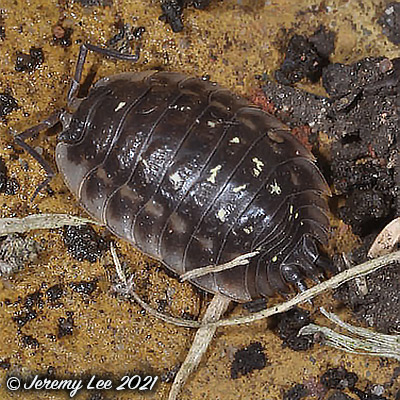
 |
|
Scientific Classifications explained » Amphibians » Ants » Aphids » Bees » Beetles » Birds » Bugs » Butterflies » Caterpillars » Damselflies » Dragonflies » Earwigs » Flies » Frog/Leafhoppers » Fungi » Galls » Grasshoppers » Harvestmen » Hoverflies » Lacewings » Ladybirds » Leaf Mines » Lichens » Mammals » Millipedes » Mosses » Moths » Sawflies » Slugs » Snails » Spiders » Trees » Wasps » Wild Flowers » Woodlice |
UK Nature > Woodlice > Oniscus asellus

Scientific Name: Oniscus asellus Common Name: Common Shiny Woodlouse Oniscus asellus, more commonly known as the Common Shiny Woodlouse, is one of the largest and most common species of woodlouse in the British Isles and Western and Northern Europe, growing to lengths of 16 mm and widths of 6 mm. They are generally flatter than other large woodlice, and their bodies are usually brownish-black in colour, with paler mottling and very pale edges to their segmental plates. Their carapace is usually rather shiny, while the underside is pale. The species can also be identified by its long pointed telson. Oniscus asellus has a strong exoskeleton and seven pairs of legs, but are born with six pairs. They have antennae that reach about half of their body length, which they use to feel around in their dark environment. The species is particularly fond of rotting wood and are one of the commonest species found under garden logs and stones in their range. They eat vegetables, various types of detritus such as dead plant and animal matter, including rotting wood. |
|

https://www.uknature.co.uk is a website dedicated to showing the immense diversity of UK nature and wildlife. Our vast range of habitats, from lowland arable to snow covered mountains, from storm-ravaged coastlines to peaceful inland freshwater lakes and rivers, from dry, sandy heaths to deciduous and coniferous forests, all these habitats contribute to the abundance of UK nature. We have wild birds in huge numbers either residing or visiting our shores (597 recorded species as at July 2013) and we must also not forget the humble back garden with its grass lawns, flower beds filled with nectar rich flowers, shrubs and trees, all designed to attract huge numbers of insects such as bees, moths, butterflies and hoverflies; and finally the small ponds which provide safe havens for frogs, toads, newts and even slow worms and grass snakes. www.uknature.co.uk is the showcase for my personal passion, photographing uknature in all its glory. I sincerely hope you all enjoy the fruits of my labours. This site and all images contained therein is © Jeremy Lee 2004 - 2021. All Rights Reserved. Site design by Jeremy Lee. Site development & IT Support by Stuart Lee. |